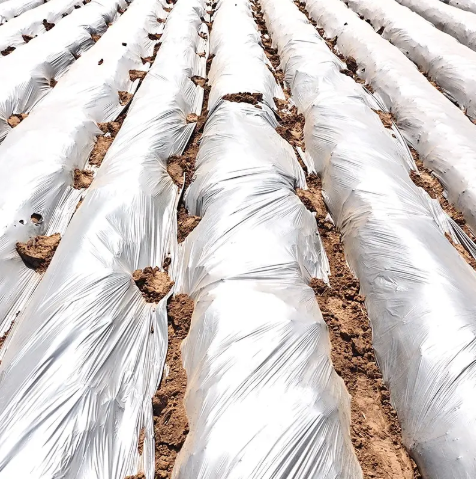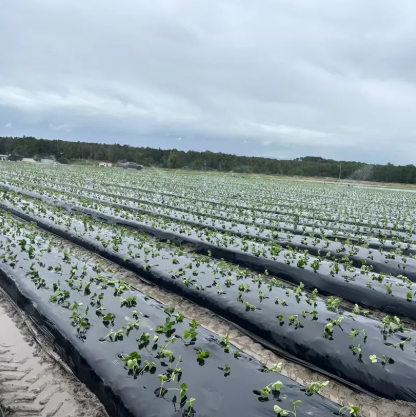Types and Applications of Agriculture Films
Clear vs. Colored Films for Light Management
Agricultural films have become pretty important in today's farming practices. When farmers decide between clear and colored plastic sheets, it really makes a difference in what grows beneath them. The clear ones let through as much sun as possible, which helps plants make food through photosynthesis. This works great in places where there just isn't enough daylight naturally. Farmers who struggle with short growing seasons find these clear films especially useful because they maximize what little sunlight comes their way. Colored films work differently though. They actually block certain colors of light while letting others pass through, which affects how plants grow. Take red films for example. Growers report better results with tomatoes when using these red covers since they seem to help the plants absorb exactly the kind of light needed for strong growth and good fruit production.
Using colored films strategically helps farmers set up microclimates that manage both light and heat better, which cuts down on plant stress and makes diseases less likely. When they tweak these small environments around their plants, growers can adjust conditions specifically for delicate crops such as tomatoes or cucumbers that need careful handling. We're seeing quite a movement across the industry towards colored films lately, especially for growing produce where controlling light really matters for getting good yields and maintaining quality standards. These films give farmers exact control over how much light reaches their plants, making them pretty essential tools for boosting farm output. Farmers adopting this approach are actually working toward something bigger too - more sustainable ways of farming while still keeping things productive.
Specialty Films: Biodegradable and Multi-Layer Options
Farmers across the country are turning to biodegradable films as part of their sustainability efforts. Made from things like corn starch or potato peelings, these materials actually break down over time instead of sitting forever in landfills. What makes them so appealing? Well, after serving their purpose in crop protection, they turn into regular old compost rather than becoming another plastic problem to deal with. Some growers report cutting down on waste collection costs by half since switching to these alternatives. While not perfect solutions yet, many see them as real progress in making farming less harmful to our planet's health.
Another big step forward in farm film tech comes from multi layer films that last longer and work better across different growing situations. What makes these special is how they pack several features into one product. Think UV blocking, water holding capacity, and temperature control properties that match what crops need where they're planted. Farmers in sunny areas especially appreciate being able to keep soil moist without letting those damaging sun rays get through to their plants. As governments around the world push harder for greener farming practices, we've seen more growers switching to these specialty films lately. Beyond solving real world problems on farms, these films help meet the paperwork requirements many places now have for sustainable agriculture.
Climate-Driven Selection Criteria
Matching Anti-Fog Ratings to Humidity Levels
Getting how humidity affects condensation matters a lot for farming operations, particularly when picking out anti-fog films for greenhouses and tunnel systems. Areas that stay damp most of the time need films with higher anti-fog ratings so growers can see through them and plants still get enough light. Farmers who add anti-fog treatments to their plastic covers tend to notice less moisture collecting inside, which helps create better growing conditions overall. Some field tests have shown that crops grown under properly rated anti-fog films actually produce more yield compared to those without. For anyone running an agricultural business, choosing the right film based on local weather patterns isn't just smart it's practically necessary if they want to get the most out of their land and investment.
UV-Stability Requirements by Geographic Region
In areas where UV rays are particularly strong, farmers need to go for agricultural films that stand up well against sun damage. These durable films don't break down as quickly and last much longer, which really matters when trying to keep farming costs under control. When growers check out their area's UV levels, they get a clearer picture of how long different films will hold up before needing replacement. Studies show that going with UV resistant options means fewer trips back to the store for new film rolls, saving money over time. Picking the right type of film according to where it'll be used makes all the difference too. Farmers who match their film choice to local conditions often find their crops grow better throughout the season while using less water and other inputs along the way.
Material Properties for Optimal Performance
Light Diffusion Needs for Specific Crops
Getting the hang of how light spreads through agricultural films makes all the difference when applying them to different crops. Take leafy greens for instance they really need that soft, scattered light instead of harsh direct sunlight. This helps avoid those burnt leaves we all hate and keeps growth nice and even across the whole plant. Farmers who switch to specialized diffusion films often see healthier plants too. The plants just seem to take in more light during photosynthesis, which means bigger harvests at market time. Research points to certain diffusion levels working best for particular crops depending on what stage they're in. So growers should match their film choices carefully to what each crop actually needs in terms of light exposure if they want to get the most out of their fields.

Thickness-to-Wind Speed Ratio Calculations
Getting the right thickness for agricultural films based on local wind speeds matters a lot if we want to avoid damage and keep them lasting longer. Farmers need to pick the correct film thickness carefully, especially when they're dealing with regions that get hit by strong winds regularly. Thicker materials often become necessary in such places to hold up against tough weather conditions. Most experienced growers will tell anyone who'll listen about doing proper wind speed checks before installing any plastic coverings. These assessments really cut down on the chances of holes forming in the material, which means fewer problems with crops getting damaged. When farmers understand how different wind speeds affect what thickness works best, they protect both their investment in the film itself and maintain good protection for their plants throughout growing seasons.
Structural Integrity Considerations
Frame Spacing Guidelines to Prevent Tearing
Getting the right distance between frames matters a lot for keeping agricultural films intact and preventing unwanted tears. Most farming guides recommend certain spacing numbers depending on what kind of plastic film we're talking about, and these recommendations come from years of field testing across different regions. When farmers install their structures with frames closer together, they tend to see fewer problems when storms hit or strong winds blow through. Checking those frame distances regularly makes sense too because it helps extend how long the film lasts while making sure everything stays sturdy enough to handle whatever Mother Nature throws at it. A little maintenance goes a long way in protecting investment against damage from outside forces.
Reinforced Edges for High-Wind Installations
When it comes to keeping agricultural films intact in windy areas, reinforcing those edges makes all the difference. Research shows time and again that when these films fail, it's almost always at the edges first. That's why farmers are turning to stronger materials specifically designed for edge reinforcement. These materials really boost how long the film lasts before tearing, especially when Mother Nature throws some serious wind our way. Farmers in places like Nebraska and Texas have seen firsthand how adding reinforcement keeps their coverings from blowing away during spring storms. This simple upgrade means better crop protection over the growing season and saves money by reducing replacement costs after bad weather hits.
Sustainability and Compliance Factors
Biodegradable Film Decomposition Timelines
Knowing how long biodegradable films take to decompose matters a lot because it tells farmers what they can expect regarding durability and environmental effects. Studies show that many of these films, usually made from stuff like corn starch or lactic acid derivatives, tend to break down within about one to two years when conditions are just right. This kind of progress helps keep farms cleaner since there's less leftover plastic lying around after harvest season. Farmers really need to understand both the advantages and breakdown times of these eco-friendly alternatives so they can pick products that fit what they're trying to achieve sustainability wise. When farmers switch to biodegradable films instead of traditional plastics, they not only help protect the environment but also streamline their day to day operations on the farm.
Recyclable Material Standards by Country
Knowing what materials count as recyclable matters a lot for farmers who want to follow local rules and boost sustainability on their land. Recycling standards actually differ quite a bit from one country to another, which affects everything from compost piles to plastic containers in barns. Getting involved in nearby recycling programs helps farmers hit those green targets while sometimes earning them actual rewards for doing things right. Some research shows that when farmers get straightforward info about what counts as recyclable stuff, they tend to participate more regularly. When growers take time to learn these guidelines and work them into daily farm routines, they're making real contributions toward protecting the environment. Plus, communities often step up with support for farms that go the extra mile with sustainability.
FAQ Section
What are the benefits of using clear versus colored agricultural films?
Clear films allow maximum sunlight penetration, promoting photosynthesis, while colored films filter light wavelengths to favor targeted plant growth, creating specific microclimates.
What makes biodegradable and multi-layer films unique?
Biodegradable films decompose naturally, reducing environmental impact, while multi-layer films offer properties like UV protection and moisture retention, improving durability.
How important are anti-fog ratings in film selection?
Anti-fog ratings are crucial in high-humidity regions to prevent condensation, maintaining visibility and light transmission for optimal plant growth and increased crop yields.
Why is UV stability essential for agricultural films?
UV stability prevents film degradation in intense UV regions, extending film lifespan and reducing replacement frequency, leading to cost-effective operations.
How do thickness and wind speed relate to film durability?
Matching film thickness to regional wind speeds prevents damage, ensuring film durability and consistent crop protection, especially in high-wind areas.
What is the significance of frame spacing and edge reinforcement?
Proper frame spacing reduces film stress, minimizing tears, while reinforcing edges enhances durability against high winds, protecting crops and extending film life.
What should farmers know about biodegradable film timelines?
Biodegradable films can decompose in 1-2 years, reducing waste. Farmers should understand these timelines to incorporate them into sustainable farming practices.
Why must farmers comply with recyclable material standards?
Complying with these standards improves sustainability, aligns with regulations, and may offer incentives, benefiting both the environment and community support efforts.
Table of Contents
- Types and Applications of Agriculture Films
- Climate-Driven Selection Criteria
- Material Properties for Optimal Performance
- Structural Integrity Considerations
- Sustainability and Compliance Factors
-
FAQ Section
- What are the benefits of using clear versus colored agricultural films?
- What makes biodegradable and multi-layer films unique?
- How important are anti-fog ratings in film selection?
- Why is UV stability essential for agricultural films?
- How do thickness and wind speed relate to film durability?
- What is the significance of frame spacing and edge reinforcement?
- What should farmers know about biodegradable film timelines?
- Why must farmers comply with recyclable material standards?

